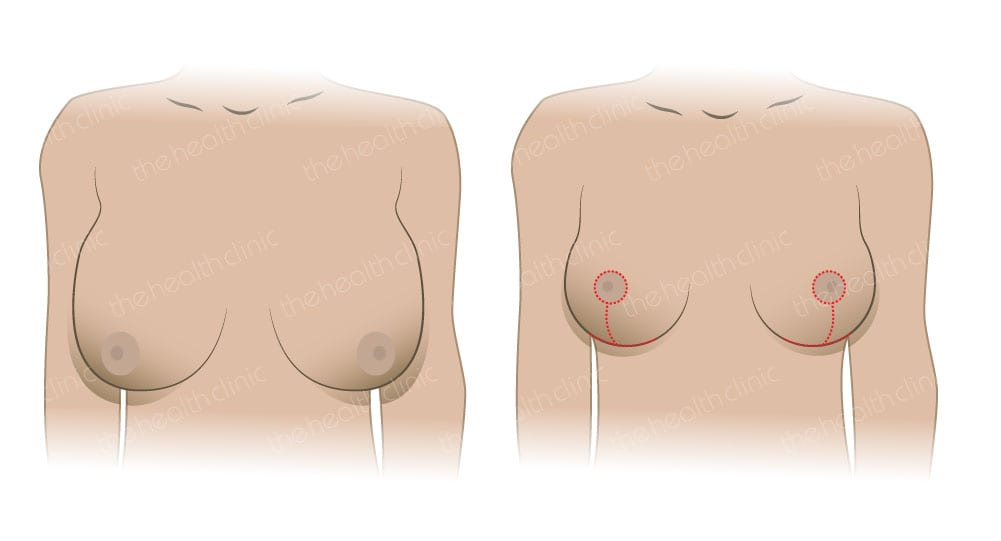Breast Reduction
- Home
- Plastic Surgery
- Breast Reduction
Breast size and weight can restrict movement and limit exercise possibilities. Because of the pressure big breasts cause there may be posture defects, tension in the shoulder and spine region and head aches. Breast reduction surgery means the reduction of excessively large breasts. Depending on the initial size of the breasts, it is possible to achieve an appropriate smaller breast shape.
| Surgeon | Dr. Siim Simmo / Dr. Mart Eller |
| Anesthesia | General |
| Surgery duration | 2-3,5 hours |
| Nights at hospital | 1 |
| Sick-leave | 1-2 weeks |
| Price | from €4690 |
| Medical loan | starting from €119 per month. Apply here. |
Ask for more information or book a time |
Most common problems
 There are women whom nature has gifted with breasts larger than the rest of their body. Breast size and weight can restrict movement and limit exercise possibilities. Because of the pressure big breasts cause there may be posture defects, tension in the shoulder and spine region and head aches.
There are women whom nature has gifted with breasts larger than the rest of their body. Breast size and weight can restrict movement and limit exercise possibilities. Because of the pressure big breasts cause there may be posture defects, tension in the shoulder and spine region and head aches.
Women with excessively large breasts often have problems with self-confidence and their body; psychological problems are also exhibited.
What can be changed with the aid of breast reduction surgery?
Breast reduction surgery means the reduction of excessively large breasts. Depending on the initial size of the breasts, it is possible to achieve an appropriate smaller breast shape. Discuss with your surgeon whether your request can actually be performed or not. Often a breast lift and repositioning of the nipples to a new, higher position must also be performed. The operation also helps to correct vast differences in the sizes of breasts (asymmetry).
In some cases, lactation can be limited after the operation. If you are planning to get pregnant, it is advised that you delay this operation until a later period.
Your personal ideas and expectations
Breast reduction surgery can improve your look, increase self-confidence and mitigate complaints resulting from breast size. In order to perform the operation successfully, it is important that you are sure what sort of outcome you picture for yourself. You can show photos to your surgeon, to help visualize your conception.
Women with realistic expectations have the best results. For the most part, personal reasons support the operation. Once the decision is made, personal satisfaction and the well-being associated with it must be placed at the forefront. Improving your look can have a direct or indirect positive impact on your private and professional life.
Speak with your doctor frankly about your expectations regarding the operation; about your wishes and ideas. Following his research, your doctor will explain to you the possibility to perform surgery based on the characteristics of your breasts (skin condition, breast size and shape) and according to your wishes. He will tell you what kind of result it is possible to achieve and where the possible scars will be located.
How to prepare yourself for the surgery?
Depending on your age and genetic risk, your doctor can ask you to pass a mammogram investigation in order to exclude nodes in your breasts.
Prior to the planned surgery, you should be in as good a health as possible.
Limit your nicotine and alcohol consumption to a minimum. In addition to overall blood circulation, smoking also harms microcirculation in the surgery area. Due to this indication, it is recommended that you avoid smoking for a period of two weeks before and after the surgery.
The administration of preparations containing hormones (pills, hormonal substitution preparations) must be temporarily suspended.
The use of aspirin or any medicines containing acetylsalicylic acid, for a period of at least 14 days prior to surgery, is strictly prohibited.
You will need to withdraw from your job and private life for at least one week after the operation. If you have the opportunity to ask someone to take care of you after the operation, please speak with this person about postoperative care requirements.
It is recommended not to be too active preoperatively, in order to rest well physically and mentally after the surgery. If you have any questions or doubts before the operation do not hesitate to contact your doctor.
At hospital
As a rule, a hospital stay of one day is recommended.
Anaesthesia
Breast reduction surgery is mostly done under general anaesthesia, meaning you will be asleep during the surgery. Before surgery, the anaesthesiologist will perform the necessary research to ensure that you receive the appropriate anaesthesia.
How is breast reduction surgery performed?
The operation usually lasts from 2 to 3.5 hours. Operating techniques may vary; for the more part, the removal of surplus mammary gland and adipose tissue from the lower part of breast is combined with the adjustment of the nipple upwards and, if necessary, nipple reduction.
In some cases breast reduction surgery is performed along with liposuction of the breasts. With extremely expansive breasts this can improve the result.
Depending on breast size different techniques are used, and these determine where the scars are located.
They may occur
– around the nipple and directly below it
– around the nipple, below it and to the side, especially if the breast is floppy
– around the nipple and in a T-shape (see drawing)
Breast reduction surgery can be generally described as follows:
Firstly, prospective incision locations and the new location of nipples are marked on the skin. After disinfecting the operation area and the operation field covering, the necessary incisions are made. This is followed by the removal of as much skin and tissue are previously planned, and the nipples are removed and attached in their new location. Finally, the skin is united under the nipples and the new breast is formed.
Sutures are usually located around the nipples and longitudinally until the tuck. In the case of bigger or more prominently slumped breasts, one horizontal incision into the tuck region must be done so that an L- or T-shape scar will form. Postoperatively a bandage or special bra is set to impinge postoperative swelling. Small drainage tubes help to drain fluid from the wound during the initial postoperative period.
Postoperative hints: what should be kept in mind?
For the first few days after the operation your breasts will be sensitive and swollen. During this time, cooling applications are beneficial.
Light pain in the operation region is normal and can be alleviated with medicaments.
Administer prescribed medicaments in accordance with provided instructions.
In case of sudden pain, bleeding or sensitivity disturbances seek help from the operating surgeon. For any other unclear matters, please contact your doctor immediately.
The healing of wounds will be regularly checked. Drainage tubes are removed during the first postoperative days. Most of the suture filaments are absorbable and need no removal, but in some situations a few filaments may need to be removed.
After a few days, the bandage can be removed. During the first 3 to 6 weeks after the operation, it is recommended that you wear a tight, supporting bra, specially recommended by the doctor, to decrease swelling and to guarantee restful healing.
Scars will appear flushed and solid for a few weeks. Over time, the scars will become lighter and unnoticeable. The healing of scars can be supported with the use of special lotions and massage. To avoid pigment changes, you should avoid tanning the wound area for a period of 6 weeks.
Haematomas and oedemas disappear mostly during the first 2 weeks. Soma patients may have oedemas for a longer period, and a light tendency for swelling may persist for a few months, especially during the warmer seasons.
Movement that requires physical effort must be avoided during the first postoperative weeks. For the first 3 to 4 weeks you should certainly avoid lifting heavy objects or lifting your hands over shoulder height; otherwise you will apply too much pressure to your sutures and wound healing will be hindered. Determining a suitable time to start working or doing other everyday activities can be best advised by your surgeon.
Your breasts are sensitive to pressure for the first 2 weeks. As a rule, this complication recedes 3 to 4 weeks after the surgery.
After breast reduction surgery you may experience a slight sense of fear or even sadness. These emotions are associated with unpleasant side effects of surgeries and also the anticipation of seeing what the result looks like. In a later phase of convalescence, when you feel better, these feelings disappear quickly.
About body care: after wound bandage removal you can take showers, but warm baths exposing the wound region must be avoided. In the case of oedemas and haematomas it is recommended to use the appropriate ointments or lotions.
Breast reduction – your new look
After a few days, you will receive your first impression of your breasts’ new look. However, the breasts often tend to be very swollen, so it takes some weeks to see the final result. The final result is seen after 3 to 6 months have passed. Your doctor makes his/her best effort to leave the scars as small and unnoticeable as possible. Still, scars can not be completely invisible; initially they may be flushed and thick, later they will turn pale and thinner. Thanks to modern operating methods the scar’s position is generally hidden so you can wear a low-cut dress. In some cases, the operation’s result can be improved upon postoperatively, after a period of 6 to 12 months.
Breast reduction can cause a significant change in your appearance and self-esteem. After this operation, women feel a greater enjoyment of exercise. Most of the women are very pleased with the operation’s results and enjoy their new look. Especially when expectations for the operation’s result were realistic and the operation passed without complications, you can be satisfied and enjoy your new look.
Can breast reduction surgery be repeated?
Repeating the breast reduction surgery or breast lift operation usually does not induce problems. With the passing of the years changes in weight or natural aging may degrade the initial surgical results; therefore a request may be made to lift already decreased breasts. It is recommended that the surgeon keep in mind the technique used during the first surgery. If there is a wish to correct lately performed operation’s result, the surgeon should wait and see what the operation’s results look like.
Even after a successful breast reduction surgery, the doctor may recommend a regular check-up in order to supervise the result of surgery after a longer period of time. If you have any questions, please be sure to contact your doctor.
Basically breast reduction surgery can be repeated. Regular check-up visits with your surgeon can help prevent and correct possible complications. If there are problems, a personal decision must be taken regarding what kind of corrective methods should be used.
Gallery with before / after pictures
Breast reduction surgery is performed by Dr. Siim Simmo or Dr. Mart Eller, who are highly experienced breast surgeons in Estonia. Ask for more information or book a time.
